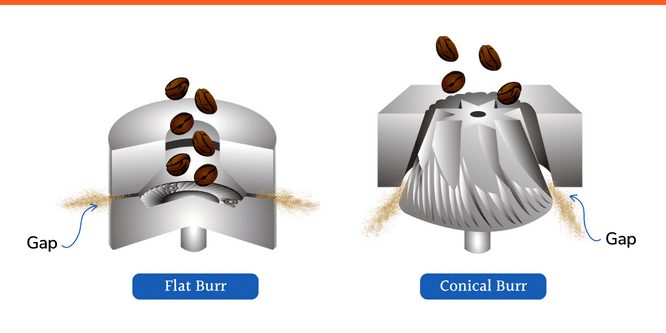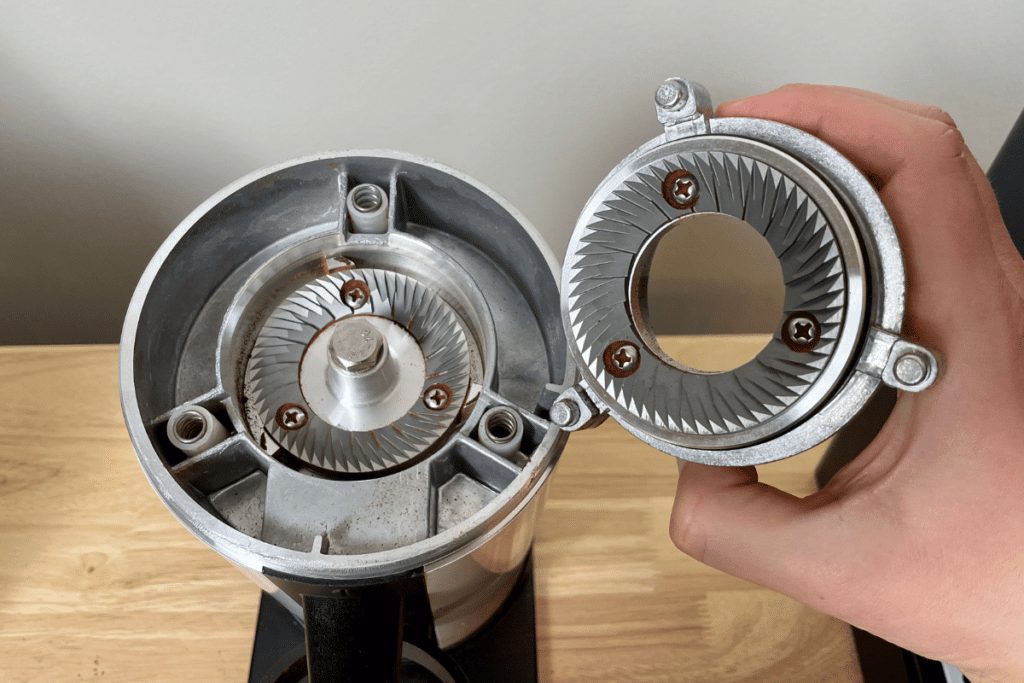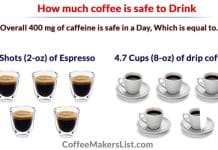Coffee aficionados know that the secret to a perfectly brewed cup lies not only in the quality of beans, but also in the grind. That is why the debate between conical and flat burr coffee grinders has been heating up among caffeine enthusiasts. While both types have their merits, understanding the key differences is essential in making an informed decision. In this article, we will explore the nuances of each grinder, shedding light on their unique features and helping you navigate the world of coffee grinding with confidence. So grab your mug and let’s dive into the conical vs. flat burr debate!
The Basics of Coffee Grinding
Understanding the Importance of Coffee Grinding
When it comes to brewing the perfect cup of coffee, the grinding process plays a crucial role. Coffee beans need to be ground to the right size in order to extract the flavors and aromas effectively. Grinding coffee beans exposes a larger surface area, allowing for a greater extraction of the coffee’s soluble compounds, resulting in a flavorful and satisfying cup.
Different Types of Coffee Grinders
Coffee grinders come in various types, but the two most common ones are burr grinders and blade grinders. Burr grinders, as the name suggests, use burrs to grind the coffee beans uniformly. On the other hand, blade grinders use a spinning metal blade to chop the beans into smaller particles.
Introduction to Burr Coffee Grinders
How Burr Grinders Work
Burr grinders work by crushing coffee beans between two abrasive surfaces, known as burrs. These burrs can be either conical or flat, and they rotate against each other to grind the beans. As the beans are forced between the burrs, they are gradually broken down into smaller particles.
Advantages of Burr Grinders
Burr grinders offer several advantages over blade grinders. Firstly, they provide a more consistent grind size, which is crucial for achieving optimal extraction. Additionally, burr grinders allow for greater control over the grind size, allowing you to adjust it to suit different brewing methods. Lastly, burr grinders produce less heat and friction, thereby preserving the flavor and aroma of the coffee beans.
Comparison with Blade Grinders
Blade grinders, on the other hand, lack the precision and consistency of burr grinders. The spinning blade in a blade grinder can result in uneven particle sizes, leading to an inconsistent extraction. Furthermore, the heat generated by the blade can negatively impact the flavor of the coffee. While blade grinders may be more affordable, they often cannot match the quality and performance of burr grinders.
Different Burr Grinder Designs
Conical Burr Grinders
Conical burr grinders get their name from the shape of their burrs, which resemble cones. These grinders have one stationary burr and one rotating burr, with the coffee beans passing between them. The shape of the conical burrs allows for a slower and more precise grinding process.
Flat Burr Grinders
Flat burr grinders, on the other hand, feature two flat and parallel burrs. The beans are crushed and ground as they are forced between these burrs. Flat burr grinders tend to operate at a higher speed compared to conical burr grinders.
Conical Burr Grinders
Design and Mechanism
Conical burr grinders are designed with two cone-shaped burrs, with one burr inside the other. The outer burr is stationary, while the inner burr rotates, grinding the coffee beans. The conical shape allows for a more gradual grinding process, ensuring a consistent grind size.
Advantages
Conical burr grinders offer several advantages. Firstly, they produce a more uniform grind size, resulting in an even extraction and a well-balanced cup of coffee. Additionally, conical burr grinders tend to operate at a slower speed, minimizing noise and reducing the risk of overheating the coffee beans.
Disadvantages
One potential disadvantage of conical burr grinders is the tendency to generate more fines, which are tiny coffee particles. These fines can lead to excess sediment in the final cup. However, this can be mitigated by selecting a grinder with better grind consistency.
Flat Burr Grinders
Design and Mechanism
Flat burr grinders consist of two parallel, flat burrs that crush the coffee beans as they pass through. The beans are ground uniformly between the two burrs due to their flat surfaces. Flat burr grinders tend to operate at a higher speed compared to conical burr grinders.
Advantages
Flat burr grinders excel at producing a consistent grind size, ensuring an even extraction and a flavorful cup of coffee. The flat burrs generate fewer fines compared to conical burr grinders, resulting in less sediment in the brewed coffee. Additionally, flat burr grinders are known for their speed and efficiency.
Disadvantages
One potential drawback of flat burr grinders is the higher risk of overheating the coffee beans due to the higher speed of operation. The increased heat can impact the flavor of the coffee, potentially leading to a less enjoyable cup. However, many flat burr grinders are designed with cooling mechanisms to mitigate this issue.
Grind Consistency
Importance of Grind Consistency
Grind consistency is crucial for achieving the desired extraction and flavor in your coffee. Inconsistent particle sizes can result in over-extraction or under-extraction, leading to bitterness or weak flavors. Achieving a consistent grind size is essential for brewing methods such as espresso, which requires precise control over extraction.
How Conical Burr Grinders Achieve Consistency
Conical burr grinders are known for their ability to produce a consistent grind size. The conical shape of the burrs and the slower grinding process contribute to a more uniform particle size distribution. This consistency allows for better control over the extraction process, ensuring a well-balanced and flavorful cup.
How Flat Burr Grinders Achieve Consistency
Flat burr grinders also excel at producing a consistent grind size. The parallel flat surfaces of the burrs work together to crush the coffee beans uniformly. This results in a more even distribution of particle sizes, leading to a more predictable and repeatable extraction.
Grind Settings
Adjustability of Grind Settings in Conical Burr Grinders
Conical burr grinders offer a wide range of grind settings, allowing you to adjust the grind size to suit different brewing methods. From coarse to fine, you can find the perfect setting for your French press, pour-over, or espresso. The adjustability of grind settings gives you the flexibility to experiment and optimize your coffee brewing.
Adjustability of Grind Settings in Flat Burr Grinders
Similarly, flat burr grinders also offer a range of grind settings to accommodate various brewing methods. Whether you prefer a coarse grind for your cold brew or a fine grind for your espresso, a flat burr grinder can deliver the desired consistency. The ability to adjust the grind size allows for customization and versatility in brewing.
Heat and Friction
Heat Generation in Conical Burr Grinders
Conical burr grinders typically generate less heat due to their slower grinding process. The reduced heat minimizes the risk of overheating the coffee beans, preserving the delicate flavors and aromas. This is particularly important for specialty coffees, where the subtle nuances can be easily lost with excessive heat.
Heat Generation in Flat Burr Grinders
Flat burr grinders, operating at a higher speed, tend to generate more heat compared to conical burr grinders. However, many manufacturers have incorporated cooling mechanisms in their flat burr grinders to dissipate this heat and prevent it from affecting the coffee beans. These mechanisms help maintain the desired flavors and prevent any undesirable changes due to heat.
Impact on Coffee Flavor
Excessive heat and friction can negatively impact the flavor of the coffee. Overheating the coffee beans can result in a burnt or bitter taste. The careful balance of heat and extraction is crucial to preserving the unique characteristics of specialty coffees. Both conical and flat burr grinders offer benefits in minimizing heat generation and protecting the flavor profile of the beans.
Price Range
Cost of Conical Burr Grinders
Conical burr grinders typically range in price from budget-friendly options to more high-end models. The cost can vary depending on factors such as build quality, brand reputation, and additional features like grind settings or built-in scales. It is important to consider your budget and brewing needs when selecting a conical burr grinder.
Cost of Flat Burr Grinders
Flat burr grinders can also be found in a range of prices, from affordable models to premium ones. Like conical burr grinders, the cost depends on factors such as materials, craftsmanship, and additional features. Investing in a flat burr grinder that meets your brewing requirements and provides durability can lead to a better coffee experience in the long run.
Factors Affecting Price
In addition to the design and features, the brand, build quality, and materials used can greatly impact the price of both conical and flat burr grinders. Higher-quality materials, such as stainless steel burrs or sturdy construction, can contribute to a higher price tag. Consider what features and specifications are important to you and find a grinder that fits within your budget.
Choosing the Right Grinder
Considerations when Choosing between Conical and Flat Burr Grinders
When selecting between conical and flat burr grinders, there are a few factors to consider. The desired grind consistency, brewing method, and personal preference all play a role in determining the right grinder for you. The conical design may provide a slower and more precise grinding process, while the flat design may offer more speed and efficiency.
Personal Preference and Brewing Method
Your personal preference and preferred brewing method should guide your decision-making process. If you value the ability to finely tune your grind size for different brews, a burr grinder with adjustable settings, whether conical or flat, may be your best bet. Consider the characteristics of the coffee you enjoy and choose a grinder that can consistently deliver on those qualities.
Budget and Durability
Budget is another crucial consideration when choosing a grinder. While there are affordable options available, it’s essential to invest in a grinder that offers durability and reliability. A well-built grinder can withstand daily use and provide consistent results over time. Consider your budget and opt for a grinder that offers the best balance between price and performance.
In conclusion, the grinding process is an essential part of brewing the perfect cup of coffee. Burr grinders, whether conical or flat, offer superior grind consistency, control over grind size, and minimal heat generation compared to blade grinders. Conical burr grinders excel at producing a slower and more precise grind, while flat burr grinders offer speed and efficiency. By considering factors such as grind consistency, adjustability, heat generation, price range, and personal preference, you can choose the right grinder to elevate your coffee brewing experience.









































